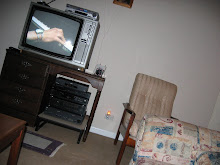Pennsylvania’s forested roots are obvious. Flying over the state you see carpets of green trees ocassionally broken by patterns of houses and then farms. There is more forest than town, as if the forest was mostly untameable. Pennsylvania changes into Ohio as the forest occasionally breaks into dense suburbs, first arranged like the cubes, squares and parallelograms of Andrei Bely's Ableukov in the novel Petersburg, each house on the end of a straight driveway, sticking out from the street. As the landscape becomes more urban, houses are crammed together in lines of squares and rectangles, not necessarily parallel or perpindicular to each other. The fields are replaced by neighbourhoods and in between the country towns of Pennsylvania and the urbanisation of Cleveland there are big stretches of farm.
Yesterday Mom, Aunt G and I went to Pittsburgh’s Strip District, where Italian, Asian and Middle Eastern supermarkets sell meats and cheeses, pastas and breads. There are restaurants and delis, grill bars and cafes. We ate in a Peruvian chicken place, where I had yucca chips, and rice and beans, and a bottle of blue corn juice chicha. We wandered around a craft gallery/shop exhibiting Latin American artists' takes on colonial impact. So there was a platinum-coated plantain hanging from a chain, animal caracases made out of used fabrics, and body suits constructed of canvas printed with photographs of skin and stitched together patchwork style – creepy and ugly.
My second pen just ran out, so enough for now.




No comments:
Post a Comment